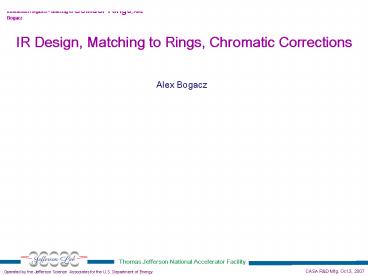Berkeley Lab Generic Presentation PowerPoint PPT Presentation
Title: Berkeley Lab Generic Presentation
1
IR Design, Matching to Rings, Chromatic
Corrections
Alex Bogacz
2
IRs with 30 mrad crossing angle Layout
Eion 225 GeV Eelectron 9 GeV
80 cm
80 cm
110 cm
260 cm
60 cm
200 cm
50 cm
240 cm
ion
10 cm
300 cm
130 cm
420 cm
electron
IR
180 cm
180 cm
300 cm
3
IRs with 30 mrad crossing angle Betas, beam
envelopes
smax 2.6/2.1 mm
Eelectron 9 GeV b 5/5 mm eN 100/4 mm rad
bmax 1.5/20 km
Quads Lcm GkG/cm 50 4.49 60 -3.14 80
3.15 80 -3.05
200 cm
260 cm
240 cm
110 cm
200 cm
260 cm
240 cm
110 cm
smax 3.7/3.3 mm
Eion 225 GeV b 5/5 mm eN 1350/60 mm rad
bmax 2.7/44 km
Quads Lcm GkG/cm 180 24.0 300 -11.3 180
19.7 180 -23.1
300 cm
130 cm
420 cm
160 cm
300 cm
130 cm
420 cm
160 cm
4
IR - matching to the Ring
Eion 225 GeV
bx 5 mm by 5 mm
FODO
IR doublet
IR doublet
matching doublet
5
Ion Ring (periodic FODO cell) 60 deg. phase
advance
phase adv./cell (Dfx 600, Dfy600)
Arc dipoles E225 GeV Lb170 cm Nin32
Ndip2116Nin gt
214 ang240/Ndip gt 1.121
deg. BPIHrang/(180Lb) gt 86.77
kG RdLb/(PIang/180) gt 8685 cm
Arc quadrupoles Name Lcm GkG/cm qF 100
10.51 qD 100 -10.46
6
Layout of one half of the Figure-8 Ion ring with
60 deg. crossing
7
Chromatic Compensation Concepts (S. Derbenev)
- Optimize the IR to provide the smallest beta star
no correcting multipoles - Use a long section of the beam extension/matching
for the chromatic compensations (i.e. insertion
of a Compensating Block (CB) before the IR). - Design a chicane (snake) CB with a special Optics
(to introduce dispersion) - Design a symmetric quadrupole/sextupole lattice
of the CB self-compensated for emittance and
squared momentum spread parasitic effects of
sextupoles - Compensation for higher order effects (spherical
aberrations, the third order forces) - Expansion of the s-Hamiltonian (2-nd, 3-rd, 4-th
order terms) - Reduction of tuning equations
- Compensation for aberrations with multipoles
8
Chromatic Compensation Block (Chicane/Snake)
R
L
L
R
PowerShow.com is a leading presentation sharing website. It has millions of presentations already uploaded and available with 1,000s more being uploaded by its users every day. Whatever your area of interest, here you’ll be able to find and view presentations you’ll love and possibly download. And, best of all, it is completely free and easy to use.
You might even have a presentation you’d like to share with others. If so, just upload it to PowerShow.com. We’ll convert it to an HTML5 slideshow that includes all the media types you’ve already added: audio, video, music, pictures, animations and transition effects. Then you can share it with your target audience as well as PowerShow.com’s millions of monthly visitors. And, again, it’s all free.
About the Developers
PowerShow.com is brought to you by CrystalGraphics, the award-winning developer and market-leading publisher of rich-media enhancement products for presentations. Our product offerings include millions of PowerPoint templates, diagrams, animated 3D characters and more.

